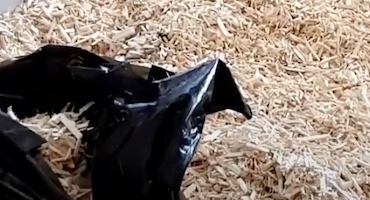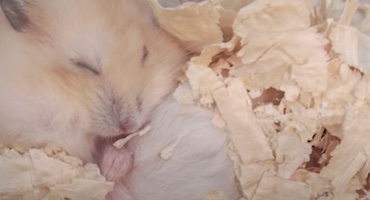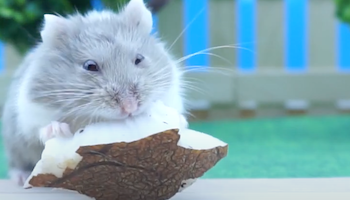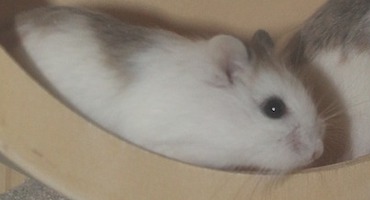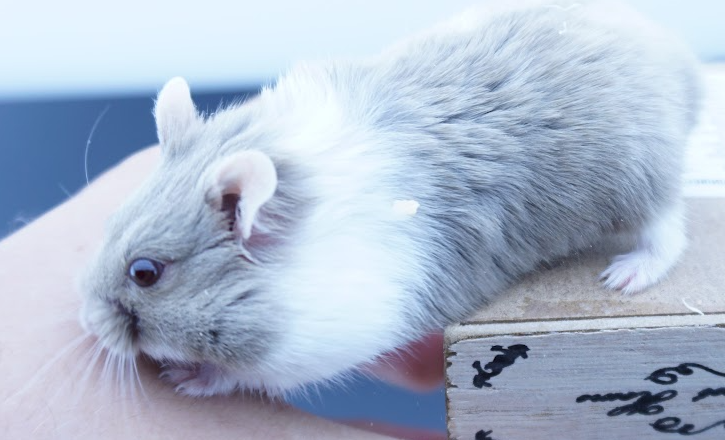Often called Chinese Dwarf Hamsters, these small rodents are not actual dwarf hamsters. They are commonly referred to as a dwarf hamster breed due to their small size.
Chinese hamsters are originally from China and Mongolia. In 1919, this breed of rodent was used for lab testing. Later in the 1900s, the Chine hamster became a popular choice for a small pet.
Although you can buy a Chinese hamster for a pet, some states have laws regarding owning or breeding this variety of rodent. California, for example, requires a permit to own a Chinese hamster.
Chinese Hamster Appearance
The Chinese hamster is tiny in size even though it is not an actual dwarf hamster. This rodent is about half the size of the popular Syrian hamster.
Chinese hamsters grow to a size of about 3 inches. These small rodents weigh between 1 and 1.5 ounces. That is about the same weight of a piece and a half of sandwich bread.
These hamsters are often confused with other hamsters due to their appearance. One distinguishing trait is the tail of a Chinese hamster is noticeably longer.
Another distinguishing trait of the Chinese hamster is a black dorsal line of fun along its back. The rest of this hamster’s hair is dark brown. This hamster’s stomach is a white or ivory color.
The behavior of the Chinese hamster
Like most hamsters, the Chinese hamster is very active. As a nocturnal animal, they are primarily active at night. This behavior is vital to remember, as you consider a Chinese hamster as a pet.
Chinese hamsters tend to have a mild temperament and are not prone to biting humans. This personality is one reason that this breed makes an excellent small pet.
However, Chinese hamsters are incredibly active and very quick. They can be challenging to handle. It is a factor to consider if you plan to have your hamster around a young child.
The average lifespan of a Chinese hamster is between 2-3 years. Some pet owners have reported their hamster living up to 4 years with very intentional care.
Housing Your Chinese Hamster
If you and your family decide to bring a Chinese hamster into your home, you want to be sure to provide it with proper housing. As a small hamster, this breed is infamous for escaping cages.
With that in mind, you may want to consider an aquarium to house your new pet. Pet stores also sell cages designed for dwarf hamsters that may be suitable for your Chinese hamster.
A proper cage should help keep your new Chinese hamster safe and happy. You want to be sure to purchase a home that is large enough for your new friend. A 24-inch by 12-inch container will be suitable for one new Chinese hamster. You may want to consider buying a larger cage if you plan to house multiple hamsters together.
Some experts argue that Chinese hamsters must be housed alone. Other experts have had success in housing multiple same-sex hamsters together.
Female Chinese hamsters tend to get more aggressive as they age. If you plan to attempt to house same-sex Chinese hamsters in pairs or groups, it is best for you to do so when they are young. If you notice any signs of aggression among your couple or group of hamsters, you should separate them immediately.
At the bottom of your hamster’s cage, you should place a layer or bedding or wood shavings. You want to avoid cedarwood as it can harm your new pet.
Inside the cage, you want to provide your new hamster with lots of toys to occupy their time. A hamster wheel is a perfect choice for your Chinese hamster. This toy will provide your pet with the opportunity to run and play for long periods.
Hamsters also need plenty of opportunities to chew. This chewing helps keep their teeth healthy and helps prevent boredom. Wooden bridges and tunnels will give your Chinese hamster the chance to gnaw.
Your new pet may also love to crawl and run through tunnels. Pet stores sell plastic tunnels in many shapes, sizes, and colors that may suit your Chinese hamster. A cost-effective toy that still stimulates your hamster is a toilet paper cardboard tube.
A hamster ball is a clear plastic toy that you can place your hamster inside of to run around. Since the Chinese hamster is often difficult for young children to handle, this is one way your kids can play with the hamster safely.
Not only does the hamster ball allow your new pet a great deal of exercise, but it also allows you a chance to clean out their cage. Keeping your new pet’s home clean is key to keeping your hamster healthy and happy.
Feeding Your Chinese Hamster
If you choose to bring a Chinese hamster home as a pet, you want to be sure your new friend gets proper nutrition. Your hamster needs a balanced diet of seeds, vegetables, and fruit.
Pet stores carry several options for seed or pellet food. Be sure to check the label on the packaged food to ensure it is appropriate for your Chinese hamster.
You may choose to give your new pet a seed blend. Pet stores also carry pellet food. This food is a good option if your Chinese hamster becomes picky with the seed blend to ensure they get all the nutrients they need.
Once or twice a week, you can give your Chinese hamster a “treat.” This treat may consist of cabbage, carrots, banana, or apples.
Don’t forget that your Chinese hamster is tiny. You want to give your pet a small portion of fruits or vegetables. For example, the right size portion of a banana is about a quarter of a teaspoon.
When you first bring your Chinese hamster home, you can test to see which treats your hamster may like best. If you notice your new pet does not eat the threat in two to three days, you may want to try a different option.
There are several foods to avoid giving to your hamster. You should never give your new Chinese hamster acidic fruits such as oranges. Be sure to thoroughly wash any fresh produce that you place in your hamster’s home.
Your pet’s droppings are a crucial sign to ensure your new friend is getting proper nutrition. If your Chinese hamster’s stool is very soft, they may be eating too many fruits and veggies. Very hard droppings may indicate that your pet is not getting enough produce to supplement their diet.
Ensuring your new pet has ample fresh water is key to a healthy hamster. Your Chinese hamster works up quite a thirst with a good deal of exercise.
You can place a ceramic bowl inside of your pet’s home to hold freshwater. Plastic water bottles that attach to the side of your cage may also be a good option. These bowls and water bottles are available at most pet stores.
Handling Your Chinese Hamster
Even though your Chinese hamster is quick and agile, you will want to tame your new hamster by handling it gently. This job may not be the most suitable task for very young children.
Once you bring your new Chinese hamster home, you should give it a couple of days to adjust to its new surroundings before taming it. You can talk to your new pet in a gentle voice. This will allow your hamster to become familiar with your voice.
After a couple of days, you can begin to reach your hand inside the cage. Be sure to use slow movements not to startle your new pet. If your new Chinese hamster seems comfortable with your presence, you can begin to stroke its back gently.
It is common for your Chinese hamster to scurry away at first. If this happens, don’t give up. Gently continue to try and leave your hand around your new pet.
Chinese hamsters are not only quick, but they are curious. They will likely get used to your hand’s presence and become more curious about it. When this happens, you may want to place a seed or a small treat in your palm.
With the treat in your palm, your new pet will begin to crawl up in your hand out of curiosity. Chinese hamsters do not typically bite. However, if you do get nipped, don’t worry.
You should slowly remove your hand from your hamster’s cage. Try placing your hand near your hamster again later.
Once your Chinese hamster is comfortable exploring your hand, you may begin to lift it slightly inside the cage. If the hamster jumps off, it’s okay. Allow the hamster to jump and try it again.
You will now be able to pick up your hamster and remove it from its cage. Don’t forget; your Chinese hamster is very active and quick. Make sure your grasp is gentle but secure.
It is also a good idea to hold your hamster over a flat surface. That way, if it does escape, it will be easier to retrieve your new pet.
Be patient and enjoy bonding with your new Chinese hamster. It is essential to begin to tame your hamster in those beginning days of bringing it into your home.
Health Concerns for Your Chinese Hamster
While cleaning your Chinese hamster’s cage weekly will help to prevent illness, hamsters do get sick.
One common illness that your new pet may experience is called “wet tail.” This condition is a hamster’s case of diarrhea.
If you notice your hamster is lazy or not eating, they may be suffering from the wet tail. Your pet will also have a damp area underneath the tail. A veterinarian will be able to give your Chinese hamster particular medicine to help with this condition.
Your small Chinese hamster may also suffer from a respiratory infection. This condition has symptoms similar to a human such as wheezing and discharge from the nose. If you notice these symptoms in your new pet, you should bring it to a vet for care.
As a rodent, Chinese hamster’s teeth grow during their entire life. To keep these teeth healthy, it is imperative your pet has opportunities to chew. These opportunities to gnaw on wooden objects will help to file away your pet’s teeth.
Your hamster may begin to gnaw on its cage. If you notice your new pet showing this behavior, you will want to provide it with new objects to bite on its cage. A wooden ladder may help to persuade your Chinese hamster to chew there instead.
Breeding Your Chinese Hamster
Before you knowingly breed your Chinese hamster, be sure you check the laws in your state. Some states have regulations regarding the breeding of this type of hamster.
Once you have decided it is both legal and safe to breed a Chinese hamster, you will want to ensure each hamster pup has a right home. Most pet stores will not take new hamster babies from private individuals.
Your female Chinese hamster will reach sexual maturity around four weeks old. It is best to wait for breeding until your female is at least three months old.
A female hamster will be in heat every four days. This is the stage you should attempt to breed your Chinese hamster.
Since hamsters can sometimes become aggressive, it is best to have a separate container for breeding. This cage should have soft bedding and be a neutral space for both the male and a female hamster.
In this space, the female Chinese hamster will tense up. When she does this, the male hamster will mount her several times. This process can take anywhere from 20 minutes to over one hour.
If your female Chinese hamster becomes pregnant, it may be hard to tell at first. The hamster’s body will begin to widen, and she will likely drink an increased amount of water.
To help your expectant mother deliver successfully, you want to clean out her cage thoroughly during the pregnancy. You also want to remove the hamster wheel and any toys that could injure a new hamster pup.
A few days before labor, you do not want to put your hands inside the female Chinese hamster’s cage. If the new mother detects your human scent on a new pup, she may reject it. This could be fatal for the new pup.
You want to ensure that your new mother has plenty of food and water in her home. Increasing her calorie intake may also help during pregnancy and delivery.
The new pups will be born with bare skin and closed eyes. Although they are adorable, resist the urge to handle the new pups just yet. You should wait at least two weeks before attempting to enter the hamster cage.
At the age of four or five weeks, you should remove the new pups from their mom. You also may want to separate the hamsters from their siblings. If you choose to house some of your Chinese hamsters together, be sure to place them with same-gender siblings.
Chinese hamster mothers will eat their own young. With that in mind, it is crucial to keep a close eye on the new little family. You also want to be sure to place the young pups in their own home after those initial weeks.
Share
Related Posts
The Campbell Dwarf hamster is named after a man named Charles William Campbell. He was the first Westerner [...]
The Roborovski hamster is the smallest breed of hamster. These hamsters are also called Rob or Robo hamsters. [...]
Winter White Dwarf Hamsters get their name from their amazing ability to change the color of their fur [...]

